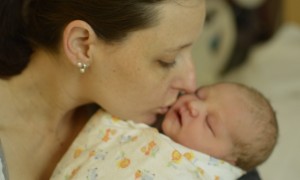Mother’s kiss sharing pathogens goes “Viral” on Facebook
New Baby 101’s post on Facebook on 15/10/15 has attracted an amazing response – More than 2.4 Million reach, 18.5K shares, and 15K LIKES with thousands of positive comments. Thanks! 🙂
New Baby 101 followers were absolutely blown away with the simple fact that kissing your baby changes your breast milk. A few people were so amazed by this information that they doubted its truth/scientific validity and requested more convincing information and references.
I am happy to provide the following references to reassure everyone of the biological fact – when a mother kisses her baby, she samples the pathogens on baby’s face, which then travel to mom’s lymphatic system. Mom’s body then creates antibodies to fight those pathogens, which baby receives through breast milk.
The words were originally from www.mothering.com/a…/10-things-might-not-know-breastfeeding/ and fully referenced in the New Baby 101 SHARE. As most health professionals who specialise in breastfeeding and human lactation know, this is an established fact of human immunology. For those who requested further details – here you go:
1. The secretory immune system invokes surfaces of the body and acts locally. Lymphocytes in the secretory immune system are different from other lymphocytes. Sensitized to antigens found in the GIT or Respiratory tracts these lymphocytes travel through mucosal lymphoid tissues where they secrete antibodies.. Most antigens to which a mother has been exposed sensitize lymphocytes migrating to the breast. There they secrete immunoglobulins in the milk – secretory IgA and slgA, Riordan, p117 Breastfeeding and Human Lactation Third Ed.
2. Maternal and infant infections stimulate a rapid leukocyte response in breastmilk
Foteini Hassiotou1,2, Anna R Hepworth1, Philipp Metzger2,3, Ching Tat Lai1, Naomi Trengove1,4, Peter E Hartmann1 and Luis Filgueira2
- 1School of Chemistry and Biochemistry, The University of Western Australia, Crawley, Western Australia, Australia
- 2School of Anatomy, Physiology and Human Biology, The University of Western Australia, Crawley, Western Australia, Australia
- 3Institute of Biochemistry and Molecular Biology, ZBMZ, University Freiburg, Freiburg, Germany
- Correspondence: Dr F Hassiotou, School of Chemistry and Biochemistry, The University of Western Australia, 35 Stirling Highway, Crawley, Western Australia 6009, Australia. E-mail:foteini.hassiotou@uwa.edu.au
4Current address: School of Health Sciences, The University of Notre Dame Australia, 33 Phillimore Street, Fremantle, Western Australia (PO Box 1225, Fremantle, 6959), Australia. Received 18 October 2012; Revised 24 January 2013; Accepted 4 March 2013
Abstract
Breastmilk protects infants against infections; however, specific responses of breastmilk immune factors to different infections of either the mother or the infant are not well understood. Here, we examined the baseline range of breastmilk leukocytes and immunomodulatory biomolecules in healthy mother/infant dyads and how they are influenced by infections of the dyad. Consistent with a greater immunological need in the early postpartum period, colostrum contained considerable numbers of leukocytes (13–70%out of total cells) and high levels of immunoglobulins and lactoferrin. Within the first 1–2 weeks postpartum, leukocyte numbers decreased significantly to a low baseline level in mature breastmilk (0–2%) (P<0.001). This baseline level was maintained throughout lactation unless the mother and/or her infant became infected, when leukocyte numbers significantly increased up to 94% leukocytes out of total cells (P<0.001). Upon recovery from the infection, baseline values were restored. The strong leukocyte response to infection was accompanied by a more variable humoral immune response. Exclusive breastfeeding was associated with a greater baseline level of leukocytes in mature breastmilk. Collectively, our results suggest a strong association between the health status of the mother/infant dyad and breastmilk leukocyte levels. This could be used as a diagnostic tool for assessment of the health status of the lactating breast as well as the breastfeeding mother and infant.
3. “When a mother kisses her baby, she ‘samples’ those pathogens that are on the baby’s face. Those are ones that the baby is about to ingest. These samples taken up by the mother’s secondary lymphoid organs like the tonsils, and memory B cells specific for those pathogens are re-stimulated. These B cells then migrate to the mother’s breasts where they produce just those antibodies that the baby needs”–when a mother kisses her baby, she ‘samples’ those pathogens that are on the baby’s face. Those are ones that the baby is about to ingest. These samples taken up by the mother’s secondary lymphoid organs like the tonsils, and memory B cells specific for those pathogens are re-stimulated. These B cells then migrate to the mother’s breastswhere they produce just those antibodies that the baby needs.– Lauren Sompayrac, author of How The Immune System Works, 2011. Wiley-Blackall
Available online:https://books.google.com.au/books?id=Vb-SCgAAQBAJ…
So, mothers who are breastfeeding your beautiful babies – RESPOND to that urge to kiss them – whenever you like. You are doing what comes naturally!
And THANK YOU to all the people who have embraced this wonderful fact of nature and shared this simple, true biological fact with someone who is special to you. You have helped to spread the wonderful truth about mothering and breastfeeding, and helped me to extend the message of “New Baby 101 – A Midwife’s Guide for New Parents” which is all about helping these new families to negotiate the steep learning curve in the early weeks and months with their precious newborn.
Visit www.newbaby101.com.au to buy Lois’ book and LIKE and FOLLOW https://www.facebook.com/newbaby101 for RELIABLE, EVIDENCE-BASED INFORMATION to guide your Birthjourney and Babymoon. Blessings X Lois



What about all the relatives who insist that they have the RIGHT to kiss newborn to one month old babies?
Hello Sandra, you and your partner are responsible for decisions about your baby’s welfare and have every right to determine who has physical contact with your baby, and who does not.